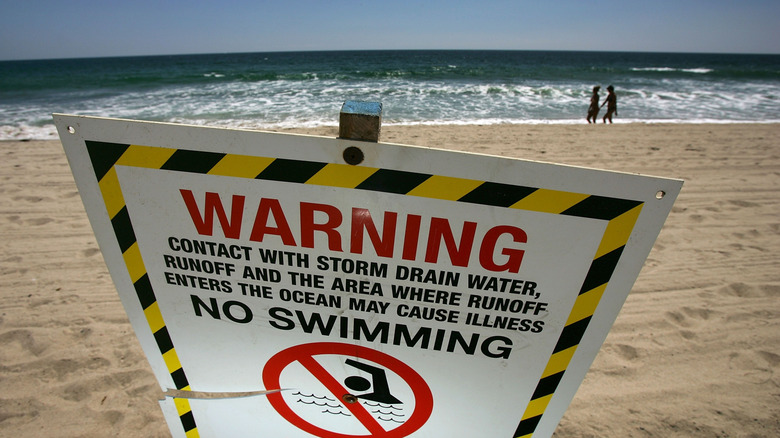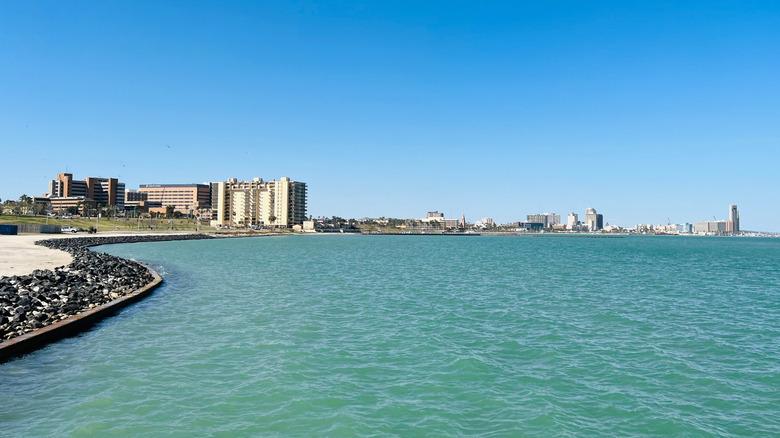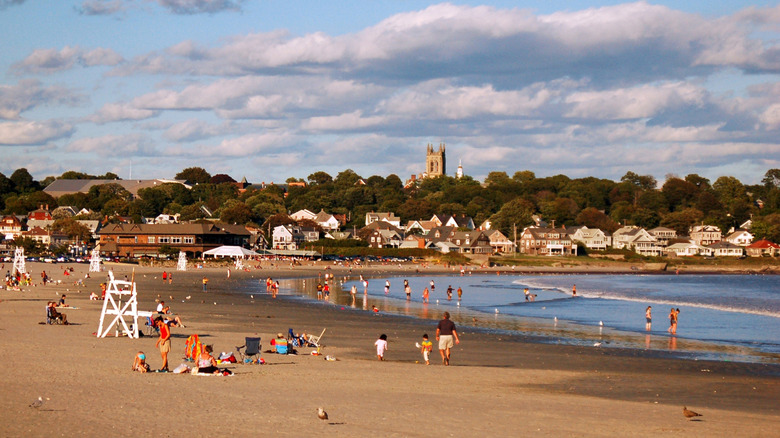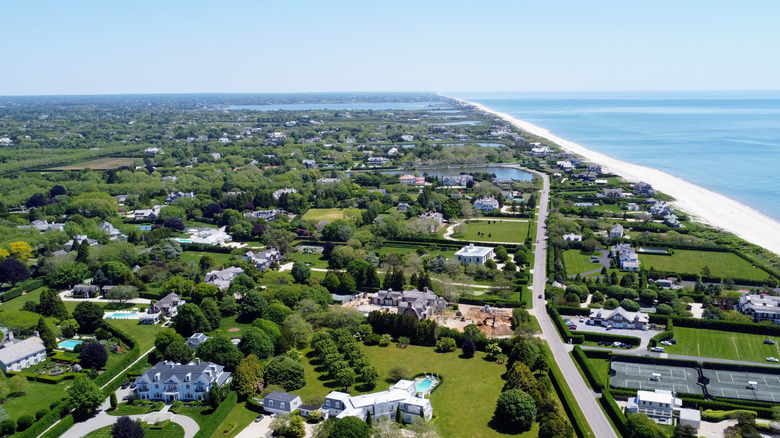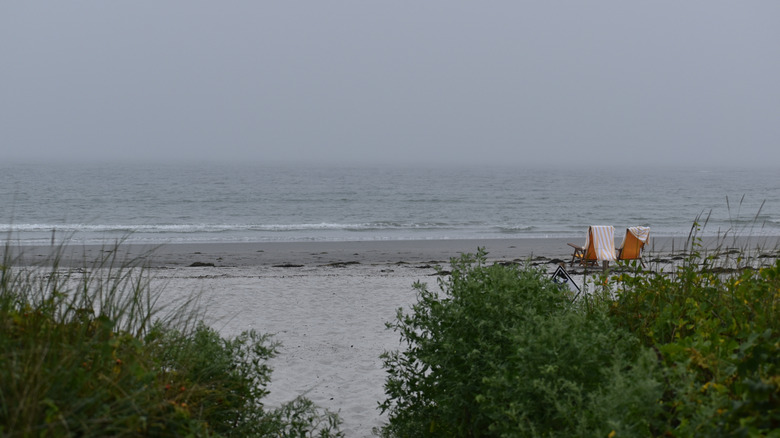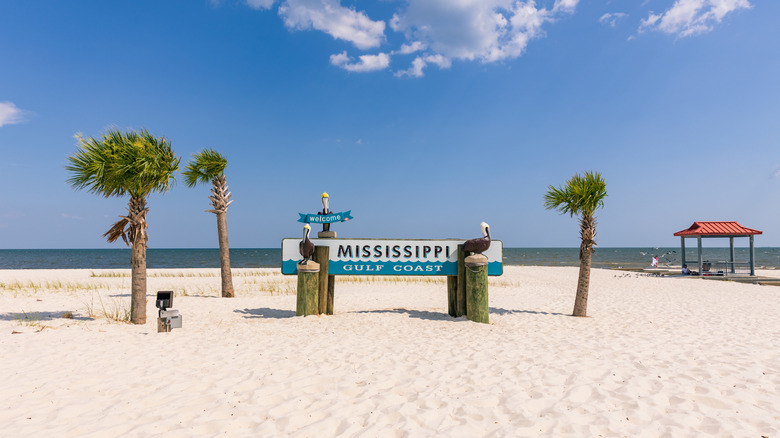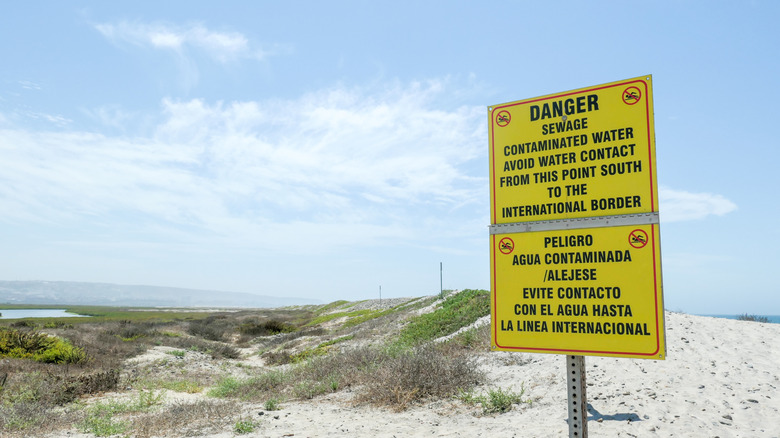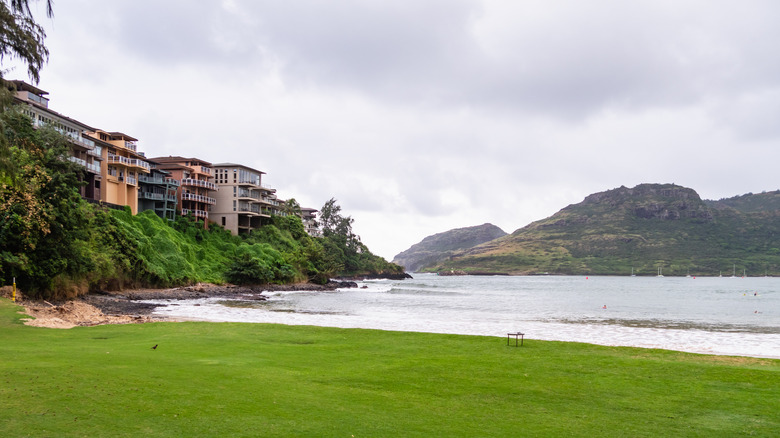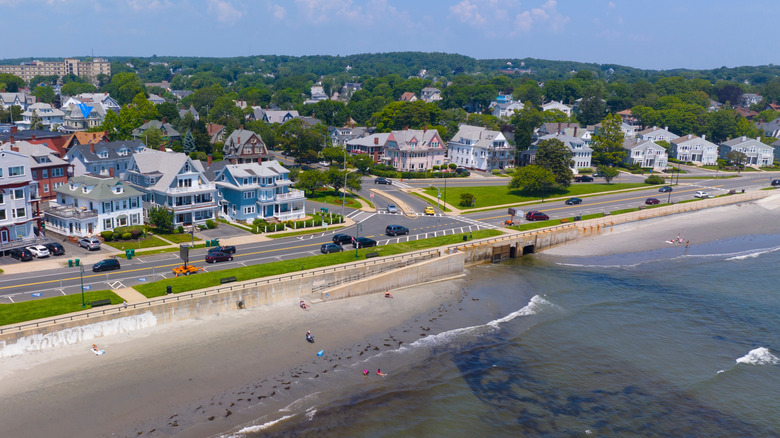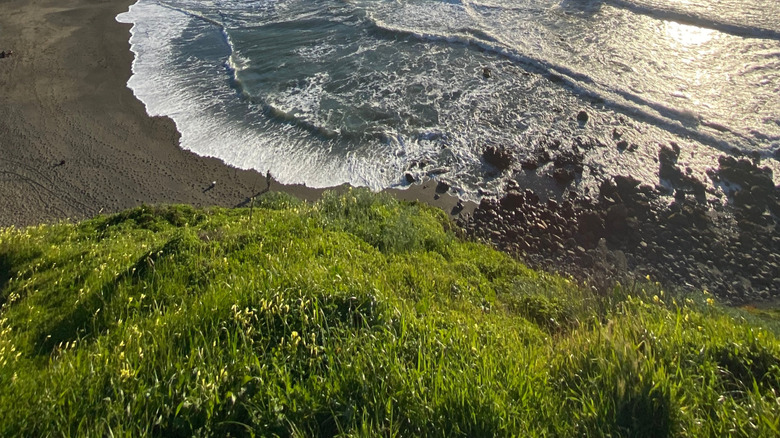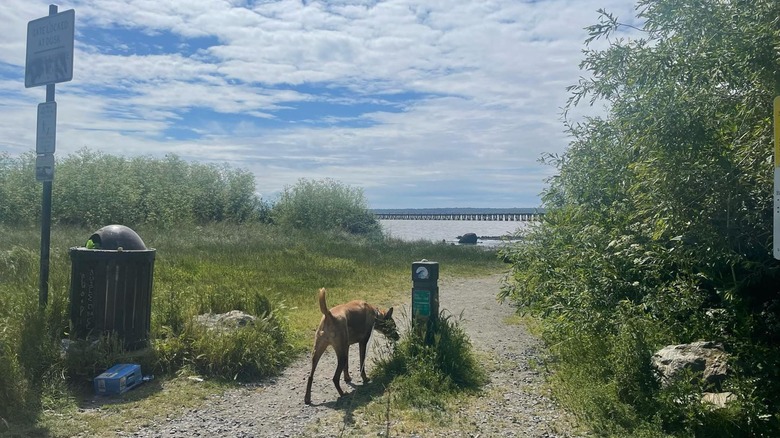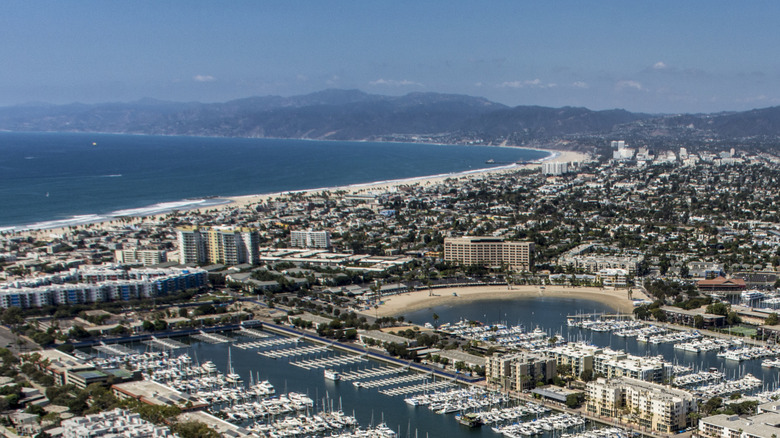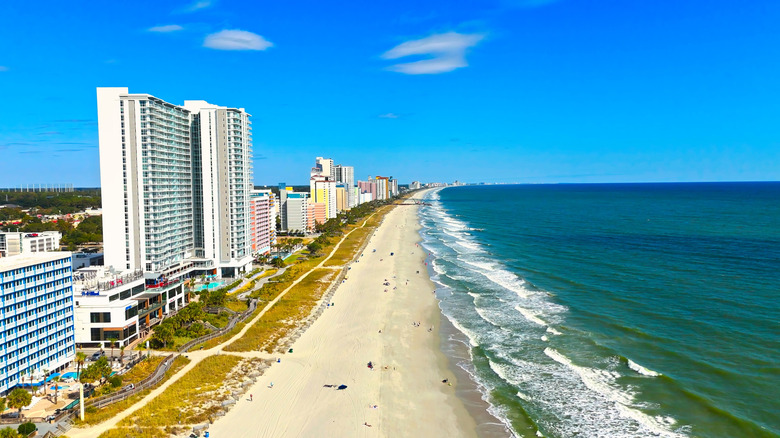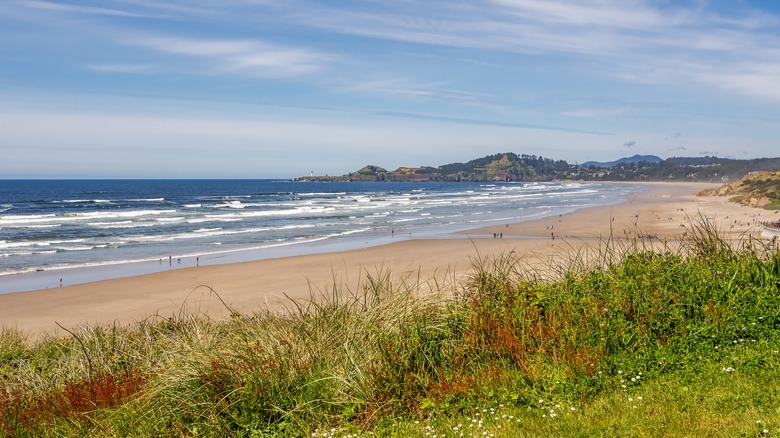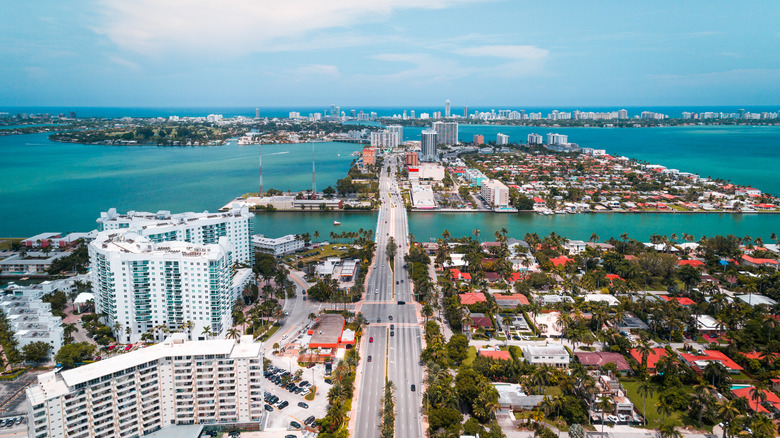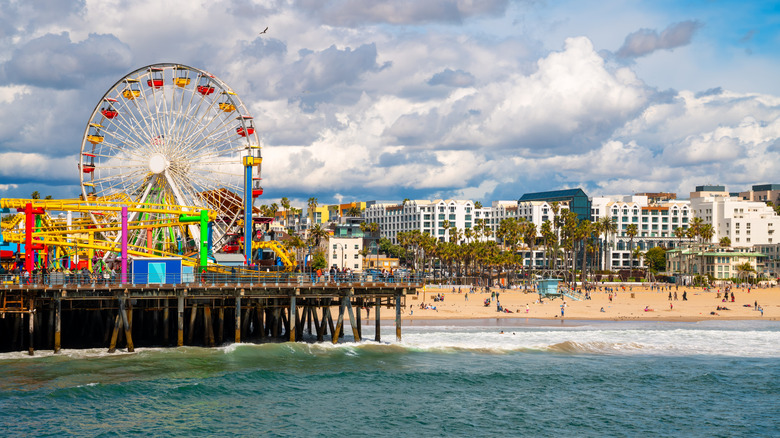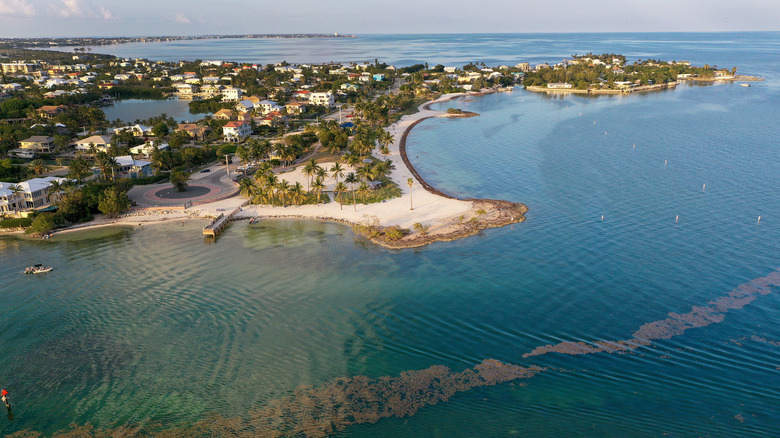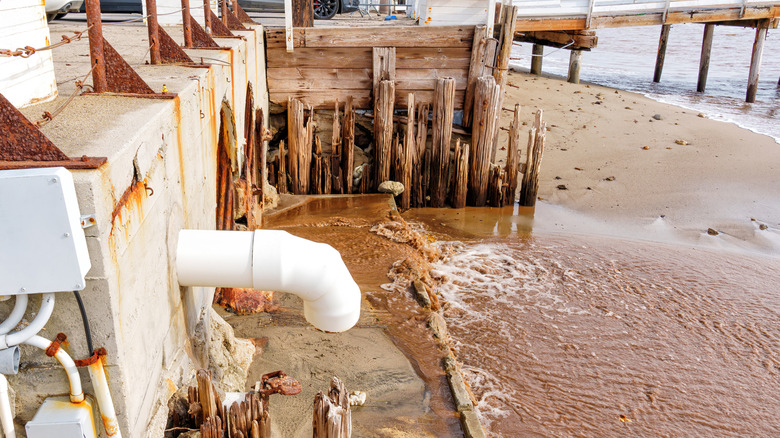These Beaches Are Considered The Filthiest In America
Many beachgoers are afraid of sharks. However, every coastal swimmer faces a considerably higher risk of being attacked by much tinier waterborne creatures. Certain beaches across the U.S. are teeming with microscopic pathogens like bacteria and parasites — and these critters don't need jaws to take a bite out of fun days at the shore.
Polluted beaches are a problem from coast to coast. Populated waterfront communities provide numerous sources of water contamination, including stormwater runoff tainted with raw sewage or dog walkers who neglect to clean up pet poop. Even beaches in rural areas can be spoiled by fecal matter from farm animals flowing downstream into the ocean.
Waterfront municipalities can minimize beach pollution by installing modern sewer systems and eradicating sources of contamination. Such efforts are certainly necessary to improve the following beaches, which rank among the dirtiest shorelines in America. During recent years, all of these coasts have been called out for excessively befouled water by eco-friendly organizations like the Surfrider Foundation, Heal the Bay, and Environment America. To provide additional information about how these beaches were chosen for this list, which is presented in alphabetical order, more details about our methodology are included at the end of this article.
Cole Park Beach – Corpus Christi, Texas
Featuring city skyline views along Corpus Christi Bay, Cole Park seems to offer ample attractions. Beyond its beach, this sprawling parkland boasts a playground, a skate park, and an amphitheater. Unfortunately, Cole Park also has persistent issues with dangerous levels of bacteria in the water — a major reason why it was excluded from a list of the most beautiful beaches in Texas.
In a report by Environment America assessing beach pollution in 2022, Cole Park was found to have the highest number of unsafe swimming days among all Texas beaches that year, followed closely by the neighboring shoreline recreation areas of Ropes Park and Poenisch Park. Luke Metzger, the executive director of Environment Texas, told the Texas Standard that much of Corpus Christi's coastal pollution is caused by the city's sewer systems being overwhelmed on rainy days. "Raw sewage has been released into our streets, into our creeks, and then ultimately into our waterways," Metzger said. While the Texas Commission on Environmental Quality is currently overseeing a community project to improve the water quality of Corpus Christi Bay, similar efforts have been attempted since at least 2012.
Easton's Beach – Newport, Rhode Island
Since the 1800s, the best beaches in Rhode Island have attracted many vacationers, including some of America's wealthiest families. The oceanfront city of Newport is still dotted with stately Gilded Age mansions that were summer homes for celebrated titans of industry. However, these days you're unlikely to find the rich and famous lounging on the sands of Easton's Beach — Environment America recently determined that this historic recreation area was unsafe for swimming more frequently than any other beach along the state's coastline.
Newport officials are striving to address the excessive levels of bacteria that plague Easton's Stream, which connects the beach area with a nearby pond that is a source of drinking water. This problem is exacerbated by increasing storm activity. According to ecoRI News, when Easton's Beach is hit by rough seas, bacteria-laden ocean spray is blown back from the coast into the freshwater pond, and "the salt spray pollution is coupled with runoff that contaminates the drinking water sources, making them harder and more expensive to treat."
Flying Point Beach – Southampton, New York
At the eastern end of Long Island, the Hamptons are a cherished getaway destination for New York's most affluent residents. But even the affluent are troubled by effluent. In the 2023 Clean Water Report issued by the Surfrider Foundation, Southampton's Flying Point Beach was determined to have the highest bacteria rate along the Empire State's coastline.
The problem that weighs down Flying Point isn't the open ocean but the stagnant water of Mecox Bay, located just inland from the beach. According to the New York Post, this enclosed bay collects stormwater from much of the surrounding community, and this runoff is frequently tainted by "the old septic systems and cesspools that the Hamptons largely depends on." To prevent the bay's bacteria levels from growing out of control, local officials periodically dig a temporary canal between the mansion-lined cove and the Atlantic, allowing polluted water to drain into the waves that crash ashore onto Flying Point Beach.
Goose Rocks Beach – Kennebunkport, Maine
The white sands of Goose Rocks Beach provide stunning views over nearby islands and frolicking harbor seals. Kennebunkport residents and visitors have long considered this shoreline as a haven for observing wildlife. Regrettably, the wildlife that Environment America observed there in 2022 was a huge population of pathogens fouling up Goose Rocks Beach at two testing sites, causing this area to be ranked as Maine's most polluted coastline.
A pair of contaminated waterways leading to the shore — Batson River and Little River — are blamed for the beach-going bacteria. Because these tidal rivers are known to regularly contain unhealthy levels of hazardous microorganisms, Kennebunkport officials posted permanent signs by Goose Rocks Beach that warn people to stay out of these sullied streams, according to WMTW. Even though the rivers that border this beach are rife with enterococci, analysts insist that the swimming area is not particularly polluted — however, torrential rain and powerful tides can raise the likelihood of unsafe conditions.
Gulfport West Beach – Gulfport, Mississippi
Mississippi's coastline is only about 70 miles long, and these days, it's becoming increasingly difficult to find stretches of it that are considered safe for swimming. In early February of 2025, the Mississippi Department of Environmental Quality issued an advisory warning that bacteria levels are hazardous at Gulfport West Beach. This very same beach was also highlighted among the state's most polluted sandy stretches by Environment America's 2022 assessment of contaminated shores nationwide.
The aforementioned advisory warned that Gulfport West Beach swimmers face a higher risk of illness due to its bacteria levels, especially following heavy rain. However, this problem appears to be spreading. In mid-February 2025, the Biloxi Sun Herald reported that additional advisories were freshly issued for additional Mississippi beaches — Bay St. Louis, Pass Christian, and Long Beach — and that recent testing "may indicate that bacteria from wastewater treatment plants, septic systems, recreational boat sewage, or other fecal contaminants are in the water."
Imperial Beach – Imperial Beach, California
The worsening issue of polluted waters at Imperial Beach is an international crisis. Located just south of San Diego, Imperial Beach is an oceanfront city that boasts a panoramic wooden pier and excellent surf breaks. But this community also sits atop California's border with Mexico — and according to a report by municipal officials, untreated sewage from the Tijuana River regularly flows into the Pacific and travels north to taint California's adjoining coastline.
Because of this cross-border situation, the sandy shore of Imperial Beach is closed as of mid-February 2025. City authorities pin the blame on operational deficiencies at the federally managed South Bay International Wastewater Treatment Plant, established in the 1990s and now considered incapable of handling the Tijuana River's high pollution levels. This ongoing environmental emergency contributed to Imperial Beach receiving the worst results possible in a recent Surfrider Foundation Clean Water Report — 100% of water samples taken there in 2023 failed to meet state health standards for beaches to allow recreational swimming.
Kalapaki Beach Park – Lihue, Hawaii
The Hawaiian island of Kauai features untarnished coastlines of pristine nature — but Kalapaki Beach Park is not one of them. Sited less than a mile from Lihue Airport, this sheltered beach is actually fairly picturesque, and a towering resort awaits nearby with a gigantic pool area. The pool should be a fine place to swim, but the beach? Not necessarily.
Officials issued a notification about Kalapaki's high bacteria count in early January of 2025, and similar proclamations have been announced here time after time for years now. In 2023, the Surfrider Foundation consistently tested the water from a stream leading to Kalapaki Beach and revealed that 100% of the examined samples exceeded allowable levels of bacterial contamination for Hawaii's recreational areas. It may not be the Hawaiian beach considered one of the dirtiest places on Earth, but pollution is also tarnishing the reputation of Kalapaki Beach Park.
King's Beach – Swampscott, Massachusetts
Since the late 19th century, families continually flock to the quaint Massachusetts town of Swampscott to enjoy its coastal charms. While the community's historic houses remain well-preserved, Swampscott's primary attraction — King's Beach — is not as welcoming as it was in the 1800s. In both 2020 and 2022, Environment America determined King's Beach to be the Bay State's most contaminated oceanfront spot.
The pollution is largely caused by infrastructural issues with Swampscott's decaying drainage system. About a century ago, a neighborhood brook was transformed to channel both sewage and stormwater directly onto King's Beach, according to the Boston Globe. Although those drainpipe systems have since been separated, untreated human fecal matter still finds its way to the ocean coast here. Some locals may be resigned to the shore's perpetual pollution. When the Globe reporter spotted a woman dipping her toes into the waters of King's Beach and asked her about the contamination, she replied: "The bacteria? It's always been here."
Linda Mar Beach – Pacifica, California
Linda Mar Beach is also known as Pacifica State Beach, but it's regrettably becoming even better known as one of California's dirtiest stretches of sand. According to the 2023-2024 Beach Report Card from Heal the Bay, Linda Mar flunked because of urban runoff draining into the ocean here along San Pedro Creek. While this incessant source of pollution may dissuade some from Linda Mar, it remains popular among surfers, sunbathers, and dog owners, since leashed canine visitors are allowed on the beach.
The presence of pets at Linda Mar may be a contributing factor to the coast's high bacteria levels. In a 2024 article published by the Coastside News, Pacific Beach Coalition leader Lynn Adams said that much of the contamination is caused by animal waste, faulty local sewage infrastructure, and the unclean condition of San Pedro Creek. "Keeping our sidewalks, gutters, yards, and streets clean will improve the health of water in San Pedro Creek and Linda Mar Beach," Adams added.
Little Squalicum Park – Bellingham, Washington
With a backdrop of Pacific Northwest woodlands and an adjoining network of nature trails, the beach at Little Squalicum Park — found just a short drive north of Seattle — appears to be an untroubled coastal idyll. But beneath the surface, this green space has endured considerable pollution in the past. The park is in the process of a long-term cleanup effort by the Environmental Protection Agency, because a nearby industrial facility tainted the area with petroleum hydrocarbons, dioxin, and other dangerous chemical compounds discovered in Little Squalicum's soil and water.
This isn't the only big problem at Little Squalicum. In 2020, Environment America declared that the park's beach water was potentially unsafe more frequently than at any other coastline in the entire state. Washington's Department of Ecology also oversees regular water testing at Little Squalicum, and from May through August in 2023, the shoreline's bacteria levels were found to exceed EPA standards on four occasions. Due to all of these undesirable traits, Little Squalicum Park is subject to a permanent swimming advisory.
Mother's Beach – Marina del Rey, California
Located deep within a sprawling harbor lined by docked pleasure boats, Mother's Beach is nestled far away from any waves hitting the Los Angeles shoreline. This results in calm waters at a swimming facility with amenities like volleyball courts, a kayaking launch, and nearby restaurants, making Mother's Beach one of many reasons why Marina del Rey is LA's coastal playground. However, the relatively stagnant water here also provides a play area for copious quantities of bacterial pollution.
Because water circulation is minimal within Marina del Rey's artificial channels, contaminants stay trapped amid the inlet leading to Mother's Beach. This turns the tranquil cove into a breeding ground for bacterial growth, earning Mother's Beach a failing grade on Heal the Bay's 2023-2024 Beach Report Card. As recently as September of 2024, the LA County Department of Public Health warned people to avoid swimming at Mother's Beach after water testing revealed harmful bacteria levels there.
Myrtle Beach — Myrtle Beach, South Carolina
The Grand Strand comprises some 60 miles of sandy beaches along South Carolina's shore, and Myrtle Beach is at the center of it all. This come-as-you-are coastline has long welcomed the masses to kick back and make a splash. Unsurprisingly, the supercharged tourism industry of Myrtle Beach and surrounding Horry County has led to pollution issues — Environment America's 2022 beach assessment found this waterfront had the highest counts of fecal bacteria statewide.
All kinds of pollutants find their way to the sands of Myrtle Beach. According to a MyHorryNews report, the Grand Strand's stormwater regularly carries pet waste, motor oil, bird droppings, and other contaminants from the community's sprawling paved surfaces into the Atlantic Ocean, resulting in long-term advisories "issued at locations where more than 10% of tests from the past five years show excessive bacteria levels." The article added that as of April 2024, 19 of Horry County's 43 beach-testing locations were under long-term advisories.
Nye Beach – Newport, Oregon
Newport's Nye Beach is a delightfully quirky destination on Oregon's rugged coast, where attractions for all ages have been a continual draw for well over a century. Regrettably for any families who were vacationing there on July 9, 2023, Newport's municipal wastewater treatment plant malfunctioned that day, and some 1.18 million gallons of insufficiently treated sewage cascaded onto Nye Beach. A Newport municipal official told KOIN that "a machine that adds chlorine to the city's wastewater broke down on the day of the spill," which lasted "for several hours."
This disgusting incident is not the first time that the waters of Nye Beach had been befouled. In the 2022 assessment of U.S. beaches carried out by Environment America, water samples from Nye were found to contain potentially unsafe levels of bacteria 77% of the time. This report ranked Nye Beach as the second-most polluted coastal area in all of Oregon that year.
Park View Island Kayak Launch – Miami Beach, Florida
While the Park View Island Kayak Launch is technically not a beach, it is a shoreside disaster. Tucked amid the island strands of ritzy Miami Beach, this watery recreation area is a branch of the Park View Island Canal, which was once popular among local paddlers. To the ire of area residents, a broken pipe dumped nearly 600,000 gallons of raw sewage into this slender channel in March of 2020.
According to the Miami Herald, so much toxic material is now compacted in this canal's sediment that its bacteria levels are in "concentrations so high that dredging, or removing silt from the bottom, may be needed to improve water quality to health levels." Additionally, stormwater from the surrounding neighborhood still flows into the water here, potentially adding new contaminants to the mix. Despite the lack of sand at Park View Island Kayak Launch, It's no wonder that the Surfrider Foundation included this waterway among its 2023 list of America's beaches requiring priority cleanup efforts.
Santa Monica Pier Beach – Santa Monica, California
A sunshiny stroll along Santa Monica Pier is one of the best free things to do in Los Angeles. The wooden walkway provides widespread vistas over LA's coastline — but while some visitors may be a little bit scared to ride the roller coaster or Ferris wheel rising above the pier, the prospect of taking a dip in the waves below should be more terrifying. The beach here is frequently ranked among the nation's worst for its poor water quality.
Considering that the Santa Monica Pier was built in 1909 specifically to house a drainpipe pumping LA's sewage out into the ocean, the murky reputation of its surrounding waters is understandable, especially since pollution issues persist here more than a century later. Heal the Bay gave this stretch of sand failing marks on its 2023-2024 Beach Report Card, as it did the year before. The environmental organization cites urban runoff and excrement from the pier's roosting birds as primary causes for bacterial contamination here while crediting local officials with taking recent steps to mitigate pollution sources.
South Beach – Key West, Florida
The Florida Keys are famous for anything-goes fun. However, if you're tempted to go into the waters surrounding this laid-back island chain, it might be wise to do anything else. Key West's popular South Beach may look like a palm-lined paradise straight out of a Jimmy Buffett song, but the water here is widely considered to rank among the filthiest swimming areas statewide.
When activists from Environment America tested the waters of South Beach on more than two dozen occasions during 2022, they found unsafe levels of bacteria there 68% of the time. Making matters worse, the contamination is not restricted to this Key West beach. According to a Newsweek report, in addition to South Beach, Smathers Beach and Higgs Beach were slapped with avoid-water advisories during the summer of 2024 because "high levels of enterococcus bacteria have been found, which is an indication of fecal pollution."
Methodology
All of the beaches in this article were recently identified as dangerously polluted swimming areas by the nonprofit organizations Environment America, Heal the Bay, and the Surfrider Foundation. Bacteria-level determinations were made based on repeated water-sample testing conducted since 2020, with more recent test results taking priority. Additionally, news reports from respected local and national media outlets provided further insights into the causes of contamination at these befouled beaches.
This article did not account for the above-water cleanliness and maintenance of these beach areas. These coastlines may be kept litter-free and be pleasant to look at. However, if authorities advise against touching the water there because of fecal pollution — even making it gross to go barefoot in the sand— we are forced to consider that beach as being filthy.
